If you find yourself in a scenario where sharing a living space with a roommate is necessary, it’s essential to understand the importance of crafting a comprehensive room rental agreement. This vital document serves to establish a clear room lease agreement and roommate contract, effectively mitigating potential issues in the future.
By having a well-crafted and thorough room rental agreement in place, you safeguard your own access to the housing and minimize the chances of conflicts and disorder if your roommate should choose to disregard the rules outlined in the agreement they signed upon moving in.
Table of Contents
Room Rental Agreement Templates
Facilitate smooth and transparent rental arrangements with our comprehensive collection of Room Rental Agreement Templates. Whether you’re a property owner renting out a spare room or an individual seeking a place to rent, these customizable and printable templates provide a legally binding framework for establishing clear and mutually beneficial agreements.
With sections covering key terms such as rental duration, rent amount, security deposit, house rules, and maintenance responsibilities, our templates ensure that both landlords and tenants are on the same page. Protect your rights and obligations, minimize potential disputes, and create a harmonious living environment with our Room Rental Agreement Templates. Download now and establish a solid foundation for a successful and hassle-free room rental experience.
What is a Room Rental Agreement?

A room rental agreement is a legally binding document that outlines the terms and conditions of renting a room within a shared living space. It serves as a contract between the landlord or primary tenant (referred to as the “rental provider”) and the tenant who is renting the room (referred to as the “roommate” or “subtenant”).
The agreement typically covers important details such as the rental period, rent amount, security deposit, responsibilities of both parties, rules for using common areas, maintenance obligations, and any additional terms specific to the rental arrangement. A room rental agreement helps establish clarity and protect the rights and obligations of both the rental provider and the roommate throughout the tenancy.
When Do You Need a Room Rental Agreement?
A room rental agreement is typically needed in the following situations:
Renting a Room in a Shared House: When you are renting a room within a house or apartment where you will be sharing common areas with the landlord or other tenants, a room rental agreement helps establish the terms of the arrangement.
Subletting a Room: If you are the primary tenant of a rental property and you plan to sublet a room to another person, a room rental agreement is necessary to outline the rights and responsibilities of both parties.
Renting a Room in a Boarding House or Rooming House: Boarding houses or rooming houses often have multiple individuals renting rooms within the same property. In such cases, a room rental agreement ensures that each tenant understands the terms of their tenancy and the rules of the establishment.
Renting a Room in a Homeowner’s Property: Homeowners who rent out a room in their own home may also use a room rental agreement to establish the terms and conditions of the arrangement with the tenant.
In all these scenarios, a room rental agreement provides clarity and legal protection for both the rental provider and the roommate. It helps prevent misunderstandings, sets expectations, and serves as a reference in case of disputes or issues during the tenancy.
What to Include in a Room Rental Agreement
A Room Rental Agreement, also known as a Roommate Agreement, is a contract that outlines the terms and conditions of shared living space between the principal tenant (the person who originally rented the property) or landlord and another tenant (the person who is renting a room).
Here are some of the key elements that should be included in a Room Rental Agreement:
Names of the Parties: Include the full names of the landlord or principal tenant and the tenant who is renting the room.
Description of the Property: Clearly define what area the tenant is allowed to occupy, which usually includes the room and common areas like the kitchen, living room, bathroom, etc.
Term of Lease: Specify the duration of the lease. This could be month-to-month, six months, a year, or another agreed-upon time period.
Rent: Include the amount of rent, when it’s due, how it should be paid, and what happens if it’s late.
Security Deposit: Detail the amount of the security deposit, the conditions under which it will be returned, and what might cause deductions from it.
Utilities and Services: Discuss who will be responsible for utilities like water, electricity, internet, trash collection, and others.
House Rules: Outline any specific rules such as noise restrictions, smoking policy, cleaning responsibilities, pet policy, etc.
Maintenance and Repairs: State who is responsible for maintaining the room and common areas, and who should handle or report necessary repairs.
Termination of Agreement: Include the conditions under which the agreement can be terminated, notice period required, and the procedure for moving out.
Conflict Resolution: It is advisable to have a predefined method for resolving disagreements, this can help prevent small issues from escalating.
Legal Disclosures: Depending on local laws, you may need to include certain disclosures such as lead-based paint disclosures for older properties.
Signature and Date: Both parties should sign and date the agreement to show their acceptance of its terms.
Difference Between Room Rental and Roommate Agreement
While both Room Rental Agreements and Roommate Agreements deal with shared living situations, they serve slightly different purposes and address different aspects of the living arrangement.
Room Rental Agreement: This is essentially a lease between the landlord (or the principal tenant) and the tenant who is renting a room. This agreement typically addresses the relationship between the landlord and the tenant, and includes terms such as the rent amount, the security deposit, the lease duration, and the rights and responsibilities of the tenant and the landlord.
Key aspects of a Room Rental Agreement include:
- Identification of the parties involved.
- Description of the property being rented.
- Amount of rent and due dates.
- Duration of the lease.
- Policies on things like pets or smoking.
- Landlord’s and tenant’s responsibilities.
Roommate Agreement: On the other hand, a Roommate Agreement is a contract between people who live together in the same rental property – this could be an apartment, a house, or even a single room. The main purpose of a Roommate Agreement is to outline the responsibilities and rights of each person living in the shared space, including things like cleaning duties, noise levels, and how shared living costs will be divided.
Key aspects of a Roommate Agreement include:
- Names of all roommates.
- Division of rent and utilities.
- Food and grocery arrangements.
- Noise and guest policies.
- Cleaning and maintenance responsibilities.
- Procedure for conflict resolution.
In summary, a Room Rental Agreement is more about the relationship between the landlord and the tenant, while a Roommate Agreement is about the relationship between the roommates themselves. Both are important for establishing clear expectations and preventing disputes in shared living arrangements.
How to Write a Room Rental Agreement
Writing a Room Rental Agreement can be a straightforward process if you follow the correct steps. Here’s a step-by-step guide to help you create your agreement:
Title of the Document: Start by clearly titling the document as a “Room Rental Agreement“.
Parties Involved: Mention the full legal names of the landlord (or principal tenant) and the tenant who is going to rent the room.
Property Description: Specify the exact address of the property and describe the specific area the tenant will be renting. This usually includes the room itself and any common areas like the kitchen, bathroom, living room, etc.
Term of the Lease: Include the start date and end date of the lease. Mention whether the agreement is month-to-month or for a fixed term, like six months or a year.
Rent Details: Specify the amount of rent, when it’s due each month, and how it should be paid. Also mention what happens in case of late payment.
Security Deposit: Detail the security deposit amount, and the conditions for its return at the end of the lease. Mention what deductions might be made, such as for property damage or unpaid rent.
Utilities and Services: Define who will be responsible for utilities (water, electricity, internet, trash, etc.), and how these costs will be divided if shared.
House Rules: Set clear house rules regarding noise, guests, pets, smoking, and use of common areas.
Maintenance and Repairs: State who is responsible for maintaining the room and common areas, how repairs are to be reported and handled, and who covers the cost.
Termination of Agreement: Specify the notice period required for termination of the agreement by either party, the conditions under which the agreement can be terminated, and the procedure for moving out.
Dispute Resolution: Define a method for resolving disagreements between the tenant and landlord.
Legal Disclosures: Depending on local laws, you may need to include certain disclosures. For example, for properties built before 1978 in the U.S., you might need a lead-based paint disclosure.
Signature and Date: The document should end with a space for both parties to sign and date, indicating their acceptance of the terms.
Legal Advice: It’s a good idea to have the agreement reviewed by a legal professional to ensure it complies with local and national laws.
Remember, a Room Rental Agreement is a legal document. It’s important to be as specific and clear as possible to avoid any misunderstandings that could lead to disputes. If either party breaches the agreement, the other party could potentially take legal action, so make sure all parties understand and agree to the terms before signing.
FAQs
Is a Room Rental Agreement legally binding?
Yes, a Room Rental Agreement is a legally binding contract. If either party violates the terms, they could face legal consequences.
How long should a Room Rental Agreement last?
The duration of a Room Rental Agreement depends on the agreement between the landlord and the tenant. It could be month-to-month, six months, a year, or another agreed-upon duration.
Can a Room Rental Agreement be terminated early?
This depends on the terms specified in the agreement. If there is a clause allowing for early termination, it can be ended early. Usually, this requires notice and may involve a penalty or forfeiture of the security deposit.
Who should write the Room Rental Agreement?
Either the landlord or the tenant can write the agreement, but it’s important that both parties agree to the terms. It’s recommended to have the agreement reviewed by a legal professional to ensure it complies with all applicable laws and regulations.
What happens if a tenant breaks a Room Rental Agreement?
If a tenant breaks the agreement, they might lose their security deposit and could face legal action. The specific consequences would depend on the terms of the agreement and local laws.
Can a Room Rental Agreement be changed after it’s signed?
Any changes to a signed Room Rental Agreement must be agreed upon by all parties and should be documented in a formal amendment or a new agreement. It’s not advisable to make changes without the consent of all parties involved.
Do I need a Room Rental Agreement for a family member or a friend?
It’s a good idea to have a Room Rental Agreement even when renting to someone you trust like a friend or family member. The agreement helps clarify expectations and prevent misunderstandings.
Can I rent a room without a Room Rental Agreement?
While it’s possible to rent a room without a formal agreement, it’s not recommended. Without a written agreement, you may have difficulty enforcing rules or resolving disputes, and legal protections may not apply.

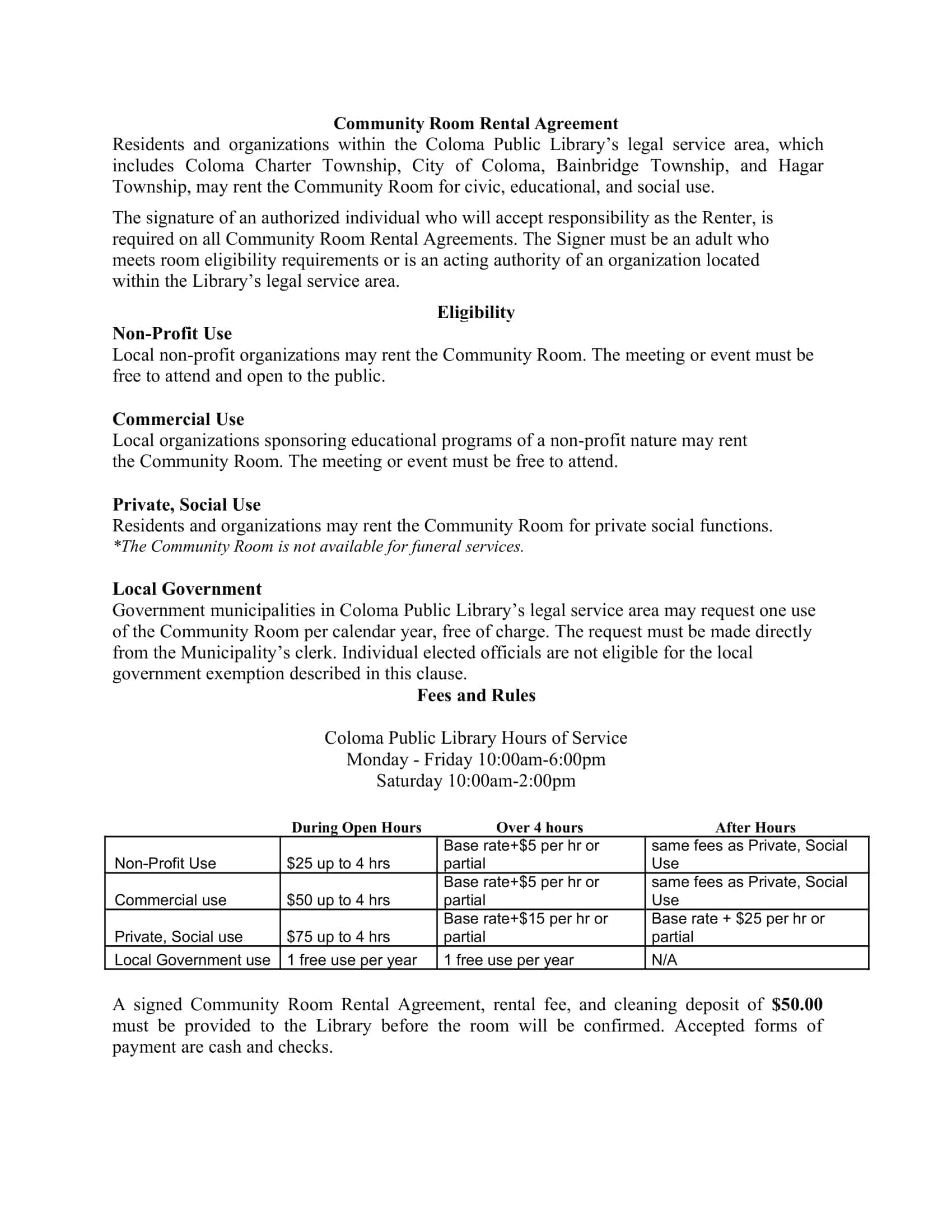


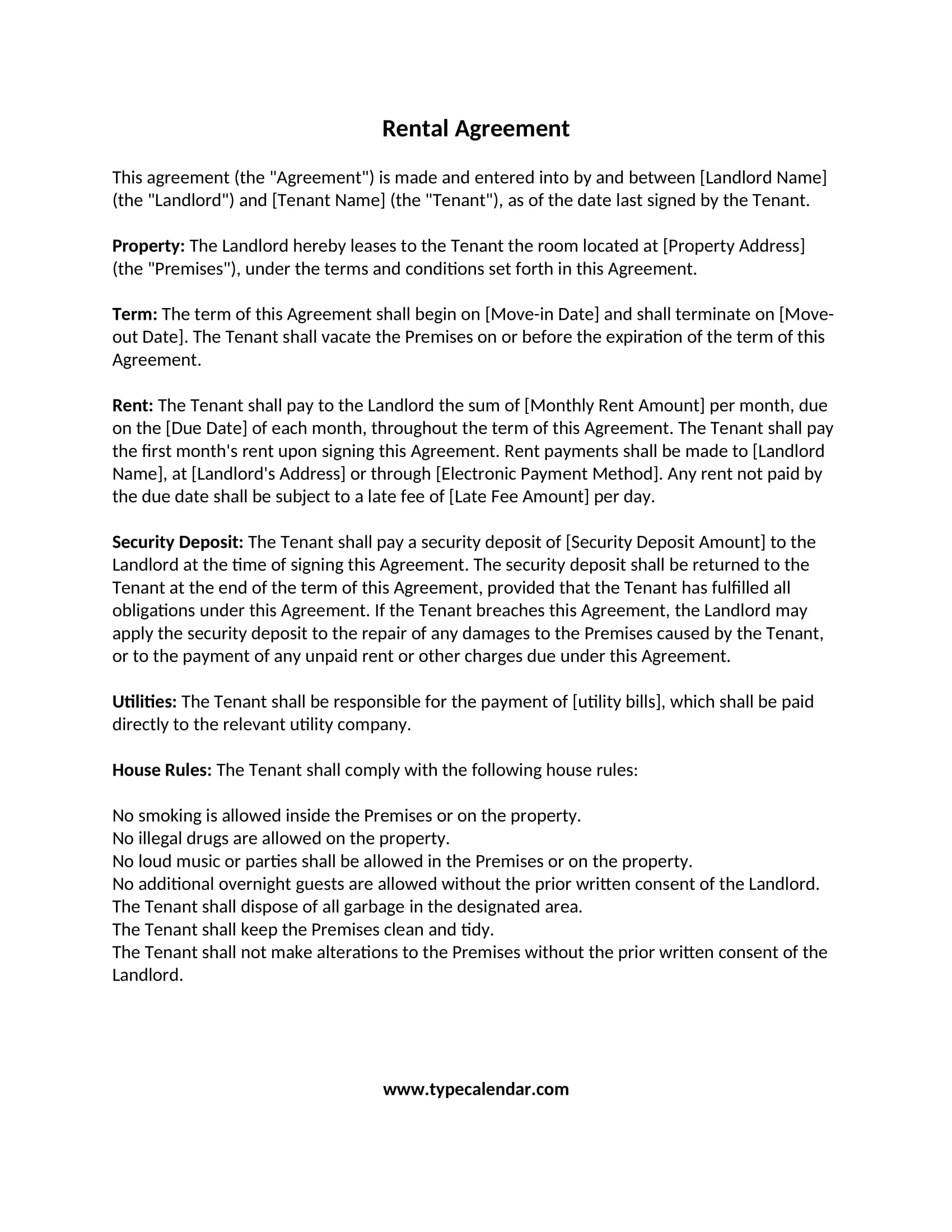
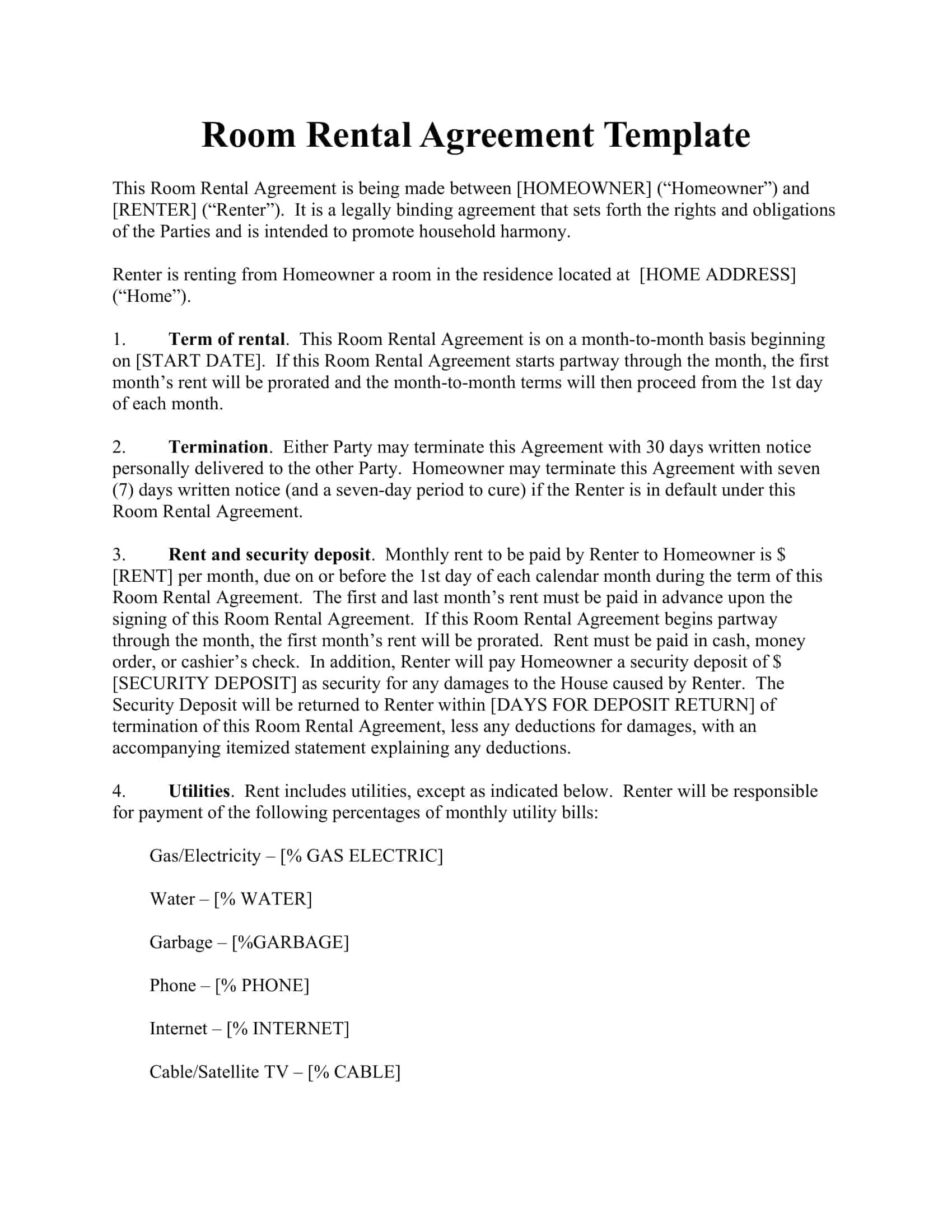


















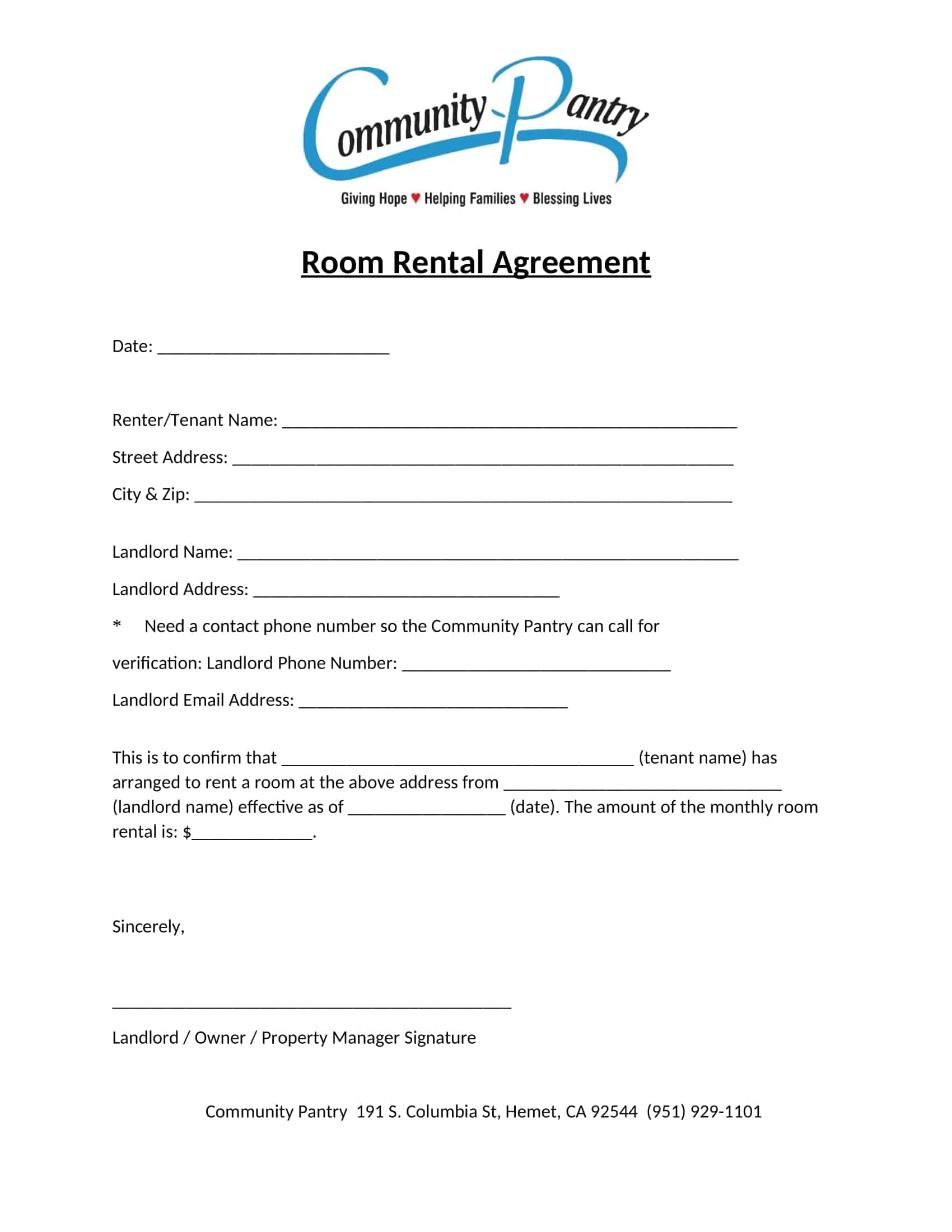











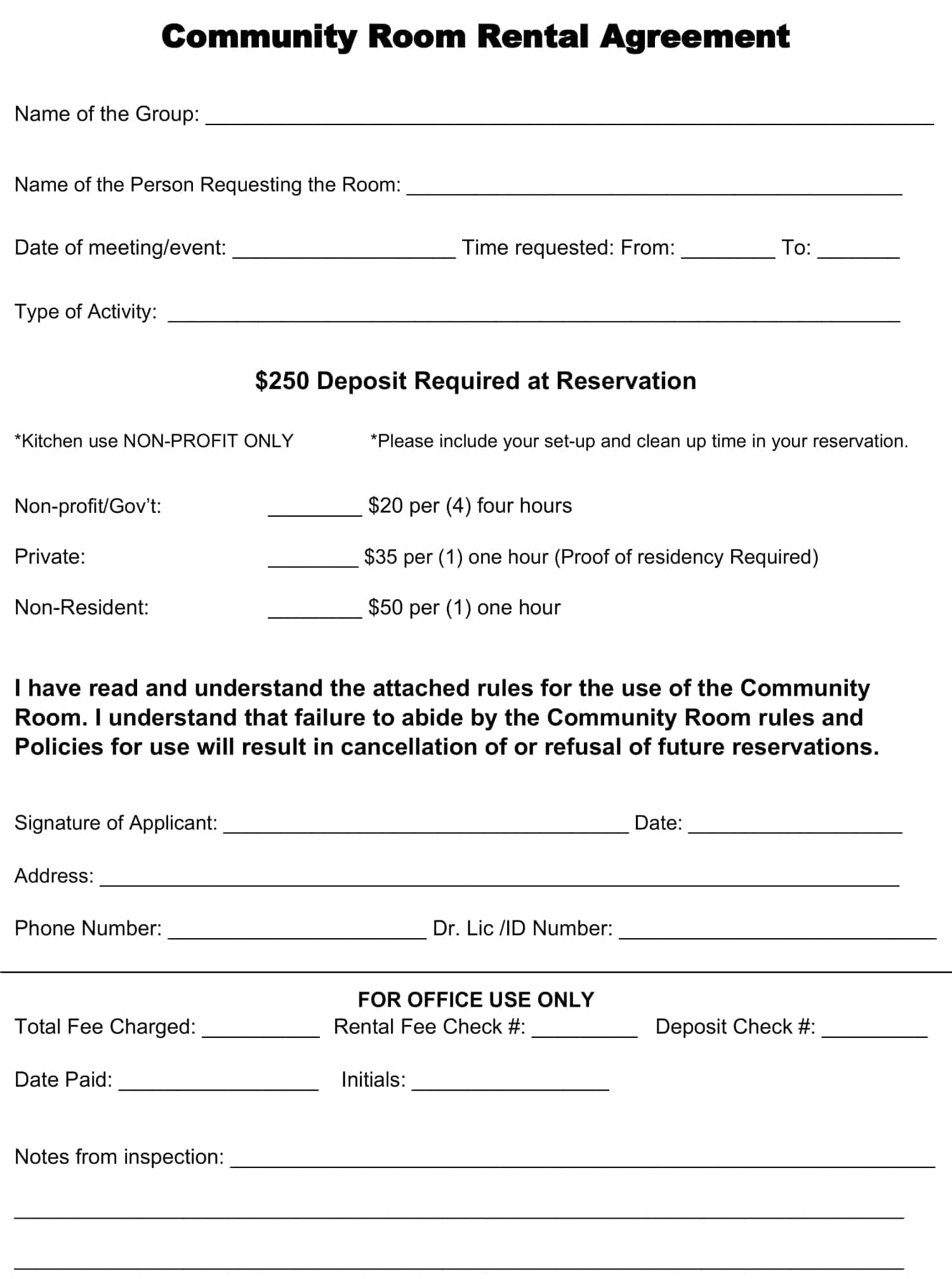
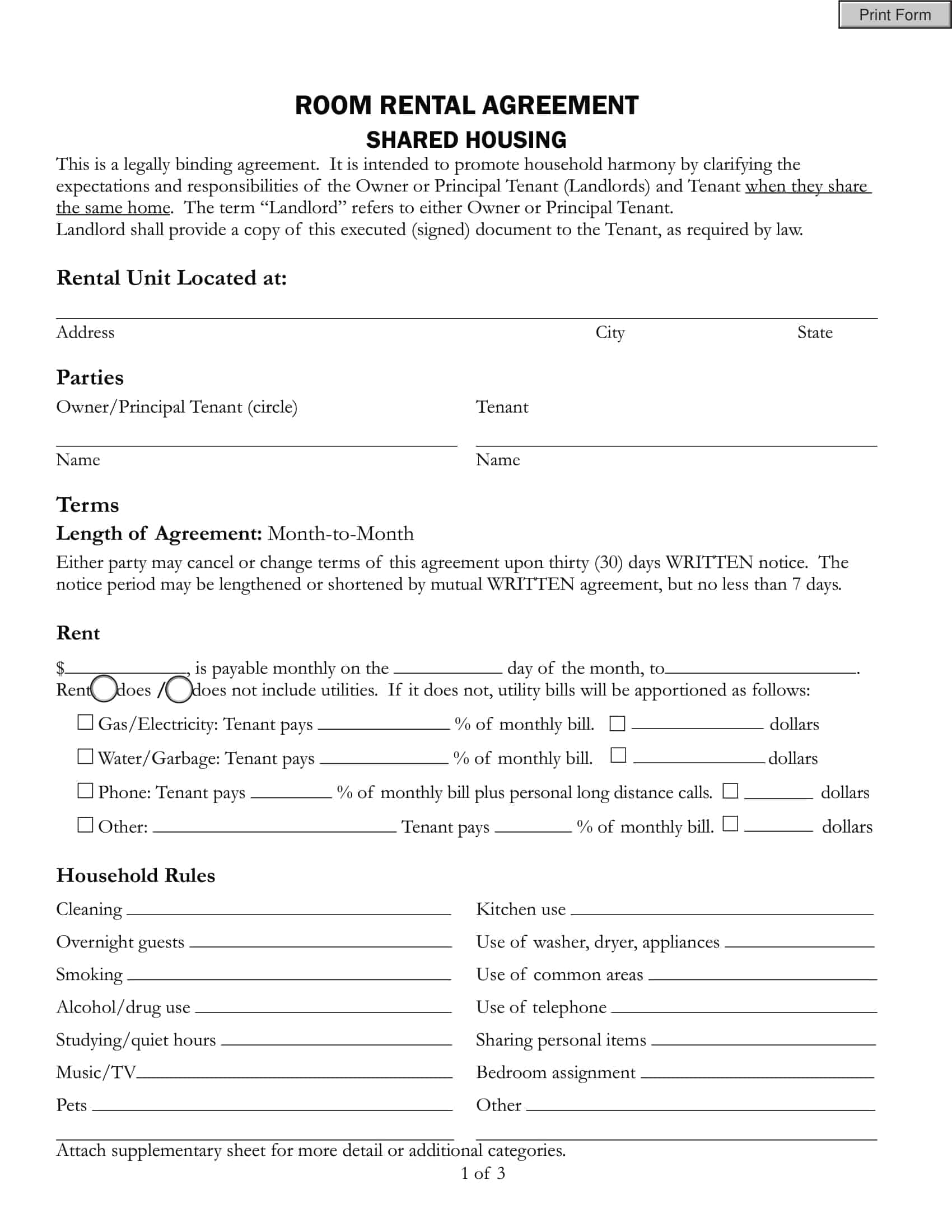







![Free Printable Roommate Agreement Templates [Word, PDF] 1 Roommate Agreement](https://www.typecalendar.com/wp-content/uploads/2023/06/Roommate-Agreement-150x150.jpg)
![Free Printable Short-Term Rental Agreement Templates [Word, PDF] 2 Short Term Rental Agreement](https://www.typecalendar.com/wp-content/uploads/2023/06/Short-Term-Rental-Agreement-150x150.jpg)
![Free Printable Payment Agreement Templates [PDF, Word] 3 Payment Agreement](https://www.typecalendar.com/wp-content/uploads/2023/05/Payment-Agreement-1-150x150.jpg)
